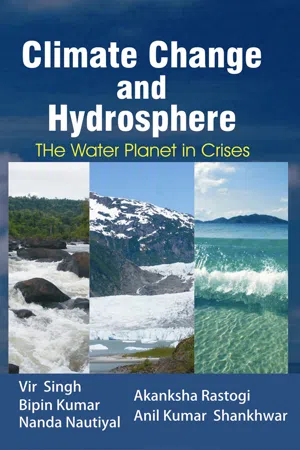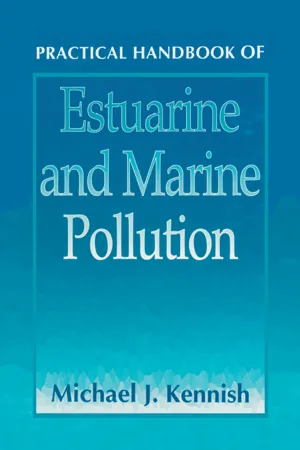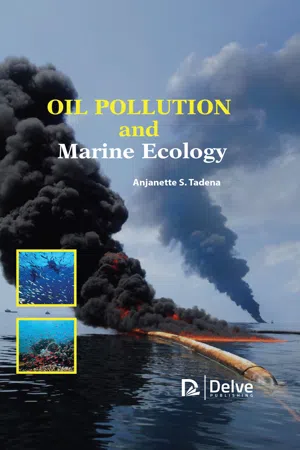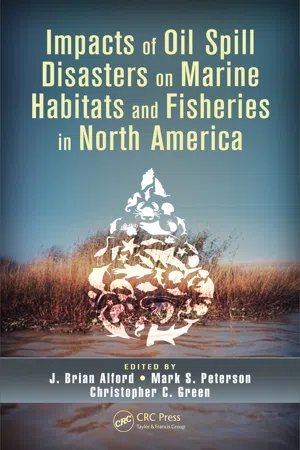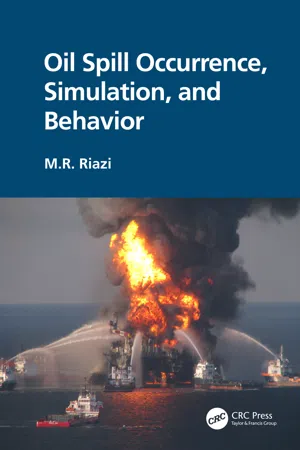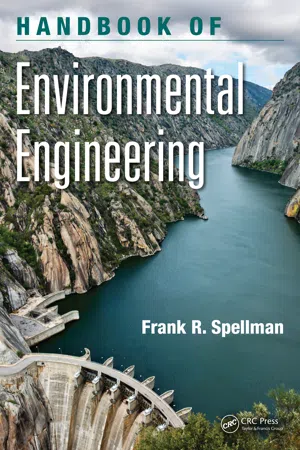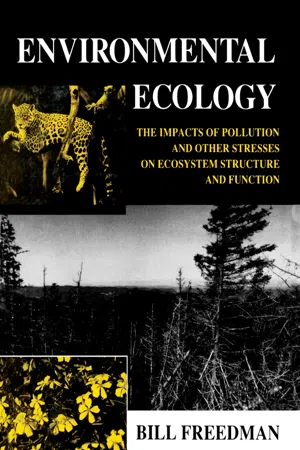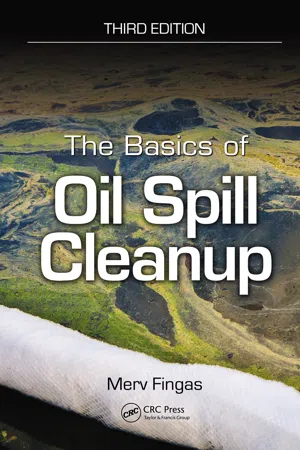Geography
Oil Pollution
Oil pollution refers to the release of oil into the environment, often due to human activities such as oil spills from tankers or offshore drilling. This pollution can have devastating effects on marine ecosystems, including harming wildlife and disrupting food chains. It also poses risks to human health and can damage coastal areas and beaches.
Written by Perlego with AI-assistance
Related key terms
1 of 5
12 Key excerpts on "Oil Pollution"
- Singh, Vir(Authors)
- 2021(Publication Date)
- Biotech(Publisher)
In this Chapter an efforts has been made to highlight the impact of disastrous oil spill which occurred in the past and proposes various methods for controlling oil spill. Introduction Today the whole world is facing problem of environmental crisis. These are natural, i.e . earthquake, landslide, cyclone, Catherina, thunder, lightning as well as man-made environmental problem, i.e . environmental pollution, global warming, ozone layer depletion, acid rain etc. Instead of developing good disaster management plan and restoration of environmentally fragile area, we can’t put much effort to control natural environmental problem, but the man-made environmental problem can be controlled by changing our life styles and implementing sound engineering control practices. When any industry is established there are always possibilities of four type of water pollution air, water, soil and noise pollution which affect whole biodiversity and degrade natural resources. Oil spill is one of the major causes of water pollution and it changes physical, chemical and biological characteristics of water which become unfit for consumption of marine life. The term often This ebook is exclusively for this university only. Cannot be resold/distributed. refers to marine oil spills, where oil is released into the ocean or coastal waters. The oil may be a variety of materials including crude oil, refined petroleum products (such as gasoline or diesel fuel) or by-products, ships’ bunkers, oil refuse or oil mix in waste. Oil spills happen when people make mistakes or are careless and cause an oil tanker to leak oil into the ocean. There are a few more ways an oil spill can occur, i.e . equipment breaking down and when countries are at war, one country may decide to dump gallons of oil into the other country’s oceans; for example the incident of Gulf war in which the massive oil slick in the Gulf happened in February 1990 due to Iran, Iraq war.- Michael J. Kennish(Author)
- 2017(Publication Date)
- CRC Press(Publisher)
3 Oil Pollution INTRODUCTIONAcute and insidious environmental problems are associated with the presence of petroleum hydrocarbons in the marine hydrosphere. The sensitivity of estuarine and marine communities to oil contamination is well established.1- 3 Major changes in the structure of these communities due to the effects of polluting oil may persist from days to years. The oil can severely impact faunal and floral populations by physical (smothering, reduced light), habitat (altered pH, decreased dissolved oxygen, decreased food availability), and toxic actions.4 In addition, chemical dispersants, solvents, and other agents used to clean up oil spills may be detrimental to estuarine and marine life.5Oil Pollution in the sea arises from multiple sources, notably spills from oil tankers, discharges during marine transportation, leakages from drilling operations, discharges from coastal refineries and marine terminals, municipal and industrial discharges, urban and river runoff, atmospheric deposition, and natural seeps.6 , 7 Of the oil entering the sea from anthropogenic activities, most (65.2%) originates from discharges of municipal and industrial wastes, urban and river runoff, ocean dumping, and atmospheric fallout. An additional 26.2% of the oil derives from discharges related to transportation (e.g., tanker accidents, deballasting, dry docking). Only about 8.5% of the anthropogenic input is attributable to releases from fixed installations (e.g., coastal refineries, offshore production facilities, marine terminals). The total oceanic input of petroleum hydrocarbons from man’s activities amounts to approximately 2.115 million tons (mt)/yr, which far exceeds that from natural sources (0.25 mt/yr) such as oil seeps.6- eBook - PDF
- Anjanette S. Tadena(Author)
- 2019(Publication Date)
- Delve Publishing(Publisher)
ENVIRONMENTAL EFFECTS OF Oil Pollution IN MARINE ECOLOGY 5 CHAPTER CONTENTS 5.1. Introduction ........................................................................................................... 80 5.2. Key Effects of Oil Pollution In Marine Ecology ....................................................... 80 5.3. Waste Oil Handling On Environment .................................................................... 84 5.4. Contaminants of Potential Concern In Waste Oils .................................................. 87 5.5. Solutions To Oil Pollution ...................................................................................... 91 Oil Pollution and Marine Ecology 80 5.1. INTRODUCTION Oil Pollution refers to an accidental or deliberate damping of oil or other petroleum products into oceans, rivers, seas, and on lands. Most common sources of Oil Pollution are a collision, cleaning of containers of petroleum products and when natural oil seep occurs. The consequences of the Oil Pollution in marine ecology are deleterious to both macro-organisms and microorganisms. Several studies have been done on the effects of Oil Pollution on water but least has been done on land. This chapter explores the effects of Oil Pollution on marine ecology. Some of the main areas discussed include: • Key effects of Oil Pollution in marine ecology. • Implications of waste oil handling on the environment. • Contaminants of potential concern in waste oils. • Solving Oil Pollution effects. 5.2. KEY EFFECTS OF Oil Pollution IN MARINE ECOLOGY Oil has a lower density than that of water therefore when mixed with water, oil floats on the water surface, imparting it a black color. For this reason, oil spills are also referred to as black tides. Timely human intervention and clean-up should be undertaken to prevent the spread of black tides (Burger, 1994) (Figure 5.2). - J. Brian Alford, Mark S. Peterson, Christopher C. Green(Authors)
- 2014(Publication Date)
- CRC Press(Publisher)
Crude Oil Pollution can be viewed ecologically as a disturbance, which is an event that reduces the abundance of CONTENTS Introduction ................................................................................................................................. 113 Factors Affecting Biodegradation of Oil in Coastal Wetlands .............................................. 115 Effects of Crude Oil on Wetland Soil and Microbial Activity ............................................... 118 Effects of Crude Oil on Wetland Vegetation ............................................................................ 121 Effects of Abiotic Estuarine Conditions on the Composition of Oil and Dispersed Oil ............................................................................................................. 123 Suggestions for Future Research ............................................................................................... 124 Appendix ...................................................................................................................................... 125 References ..................................................................................................................................... 128 114 Impacts of Oil Spill Disasters on Marine Habitats and Fisheries in North America dominant species, allowing new species to establish and less common, existing species to increase in abundance (Figure 6.2). Disturbance often leads to a partially predictable change in species abundance and eventually to a return in dominance by the original species (van der Valk 1981). These fairly predictable changes in species composition are known as succession; ecosystems that are easily disturbed are said to be more sensitive or to have less resistance whereas ecosystems that recover quickly from a disturbance are said to be more resilient (Halpern 1988).- M.R. Riazi(Author)
- 2021(Publication Date)
- CRC Press(Publisher)
There are also social impacts on human beings, e.g. health and physiological impacts, and there will 270 Oil Spill Occurrence, Simulation, and Behavior FIGURE 9.3 Economic impacts from oil spills. also be more research activities going on after the oil spills. All of these will have a further impact on the technology, regulations, and marine activities, e.g. traffic volume, oil drilling, etc. Based on the diagram of how an oil spill influences the ecology and society in Figure 9.2, the following sections are going to summarize an overall structure of the economic and financial impacts from an oil spill, as shown in Figure 9.3. First, the economic impact is divided into local and global impacts. Local impacts refer to the damage or costs to the regional environment and society. They include cleanup costs, socioeconomic loss, natural resource damage, and other costs. In the global aspect, the impact is transferred through the global financial market and has an influence on the global society. The impact may be reflected in the oil price, stock market, industry, and regulations, which further influence the global economy FIGURE 9.2 Oil spill impact framework. (Boxes = outcomes, lowercase = variables, solid lines = linkages between oil spill occurrence and socioeconomic impacts, dotted lines = link-ages between exogenous variables and outcomes) (after Chang et al., 2014). 271 Economic and Financial Impacts of Oil Spills and finance. This global impact exists mainly for the major oil spills. The local and global impacts will be discussed in the following sections in detail. 9.2.1 L OCAL E CONOMIC I MPACT The local economic impact refers to the oil spill-induced impacts related to regional economic damage and loss, including cleanup costs, natural resource damage, socioeconomic loss, and other costs in the oil-spilled water and region.- eBook - PDF
- Frank R. Spellman(Author)
- 2015(Publication Date)
- CRC Press(Publisher)
Any change in the product or process has implications for upstream stages (e.g., extraction and processing of raw materials, production and distribution of process inputs) and for down-stream stages (e.g., components of a product, its use and ultimate disposal). • Light pollution —Excessive or obtrusive artificial light (photopollution or luminous pollution). • Marine debris —Human-created waste that has deliberately or accidentally become afloat in a waterway, lake, ocean, or sea. • Marine pollution —Harmful, or potentially harmful, effects resulting from the entry into the ocean of chemicals, particles, or industrial, agricultural, and residential waste or from the spread of invasive organisms. • Noise pollution —Unwanted sound that disrupts the activity or balance of human or animal life. • Nuclear fallout —The residual radiation hazard from a nuclear explosion, so named because it “falls out” of the atmosphere into which it is spread during the explosion. • Ocean acidification —The ongoing decrease in the pH of the Earth’s oceans, caused by their uptake of anthropogenic carbon dioxide from the atmosphere (Caldeira and Wickett, 2003). • Oil spill —The release of a liquid petroleum hydrocarbon into the environment due to human activity; a form of pollution. • Ozone depletion —Ozone concentrations vary naturally with sunspots, the seasons, and latitude, but these processes are well understood and predictable. Scientists have estab-lished records spanning several decades that detail normal ozone levels during these natural cycles. Each natural reduction in ozone levels has been followed by a recovery. Recently, however, convincing scientific evidence has shown that the ozone shield is being depleted well beyond changes due to natural processes (USEPA, 2010). • Particulates —Normally refers to fine dust and fume particles that travel easily through air. • Pesticide —A substance or mixture of substances used to kill pests. - eBook - PDF
Environmental Ecology
The Impacts of Pollution and Other Stresses on Ecosystem Structure and Function
- Bill Freedman(Author)
- 2013(Publication Date)
- Academic Press(Publisher)
6.1 INTRODUCTION Petroleum is a critically important but nonrenew-able natural resource. In its refined forms it is used for the production of energy and for the manufac-ture of synthetic materials such as plastics, while its asphaltic residues are used in heating and in con-struction. Energy production is by far the largest of the uses of petroleum, globally accounting for an energy equivalent of about 119 x IO 18 J in 1983, or 45% of the total production of energy by all means (World Resources Institute, 1986). About 50% of the 1983 global petroleum use was in North Amer-ica and Europe, even though these only comprise about 14% of the human population. The global production of petroleum had a value of more than $600 billion in 1983, in constant 1980 U.S. dollars (WRI, 1986). Because most petroleum is extracted in locations that are remote from places where consumption oc-curs, it is a commodity that must be transported in a very large quantity. The most important methods of transportation are by oceanic tanker and overland pipeline. These transportation methods can pollute the environment by accidental oil spills and by oper-ational discharges (i.e., the cleaning of storage and 6 Oil Pollution ballast tanks). There have been spectacular acciden-tal spills, involving the loss of very large quantities of crude oil from disabled supertankers and offshore platforms. In addition, the large stationary facilities that are used for the refining of petroleum have the potential to cause chronic pollution by the discharge of hydrocarbon-laden waste waters, and by frequent small spills. The purpose of this chapter is to exam-ine the ecological effects of Oil Pollution from these various sources. 6.2 CHARACTERISTICS OF PETROLEUM AND ITS REFINED PRODUCTS Petroleum is a complex, naturally occurring mix-ture of organic compounds that is produced by the incomplete decomposition of biomass over a geologically long period of time. - eBook - ePub
Aquatic Pollution
An Introductory Text
- Edward A. Laws(Author)
- 2017(Publication Date)
- Wiley(Publisher)
The widespread use of petroleum and petroleum products has inevitably resulted in the discharge of oil to the environment. With respect to aquatic systems, it is the marine environment that has received the greatest attention because the majority of the more noteworthy oil spills have involved accidents at sea. The emphasis in this chapter on marine Oil Pollution is not meant to imply, however, that Oil Pollution of freshwater systems is not a serious problem. However, some of the issues associated with marine Oil Pollution, such as offshore oil drilling and use of supertankers to transport oil, are peculiar to the marine environment, whereas many of the other issues are equally relevant to freshwater and marine systems. In other words, a study of marine Oil Pollution encompasses most if not all of the problems relevant to freshwater Oil Pollution as well.Oil Discharges to the Marine Environment
Table 13.2 summarizes estimates of oil inputs to the marine environment during the period 1990–1999 (NRC 2003). In most cases the uncertainty of the estimates is rather large, and it seems reasonable to conclude that the numbers are accurate to no more than one significant figure. The following summary provides additional information on the various inputs.Estimates of petroleum inputs to the marine environment.Table 13.2Input rate (103 tonnes y−1 ) Source Probable range Best estimate Natural seeps 200–2000 600 Extraction of petroleum 20–62 38 Platforms 0.29–1.4 0.86 Atmospheric deposition 0.38–2.6 1.3 Produced waters 19–58 36 Transportation of petroleum 120–260 150 Pipeline spills 6.1–37 12 Tanker spills 93–130 100 Operational discharges (cargo washings) 18–72 36 Coastal facility spills 2.4–15 4.9 Atmospheric deposition 0.2–1 0.4 Consumption of petroleum 130–6000 480 Land based (river and runoff) 6.8–5000 140 Recreational marine vessels No data No data Spills (non-tankers) - eBook - PDF
- A. Voipio(Author)
- 1981(Publication Date)
- Elsevier Science(Publisher)
Chapter 7 POLLUTION BERNT I. DYBERN and STIG H. FONSELIUS INTRODUCTION Global aspects of pollution GESAMP, which is a permanent Working Group composed of members from several specialized agencies of the United Nations, has formulated the generally accepted definition of marine pollution as follows: “Introduction by man, directly or indirectly, of substances or energy into the marine environment (including estuaries), resulting in such deleterious effects as harm to living resources, hazard to human health, hindrance to marine activities, including fishing, impairing the quality for use of sea water and reduction of amenities”. (GESAMP 1/11, para. 12, 1974) Polluting substances may cause changes in the physical-chemical environ- ment, e.g., in temperature, salinity, pH, gas content, chemistry, colour or turbidity of the water, which in turn may influence the marine life in differ- ent ways. They may also cause direct damage to organisms, e.g., on physio- logical processes, including alimentation and reproduction, after having reached a certain threshold concentration. Pollutants have spread enormously, especially since the early 1950s, and no part of the seas, even at great depths, seems now to be completely free from them. Nobody knows how many pollutants there are, but already the pertinent new chemical compounds can be counted in tens of thousands. Fig. 7.1 gives a schematic picture of the present-day pollution of the oceans. The most disturbed areas are generally located outside industrialized land areas, from which pollutants are carried out directly through runoff and through sewers or indirectly through rivers and the atmosphere. However, there is also a certain contamination of the remaining sea areas, due, among other things, to the long-distance transport of pollutants by water and air currents. Semi-enclosed sea areas, which, like the Mediterranean and the Baltic Sea are surrounded by industrialized countries, are among the most polluted in the world. - eBook - ePub
Ecology of Estuaries
Anthropogenic Effects
- Michael J. Kennish(Author)
- 2019(Publication Date)
- CRC Press(Publisher)
Focus is placed on the sources and fate of oil in estuaries, the magnitude of its input, and the methods used to mitigate its effects. Assessment of the hazards posed by the oil includes an investigation of the toxicity of the chemical compounds comprising petroleum products in the sea to specific biological ecosystem components. In addition, details of the physical, chemical, and biological factors influencing the fate of oil in the estuarine environment are presented. Sources of Oil Pollution The total input of oil to estuaries is difficult to estimate because most statistics available do not separate the oil entering estuarine areas from that released to other marine waters. 3 Carlberg 3 estimates that more than 33% of the entire input of oil to the marine hydrosphere may enter estuaries. Abel 4 notes that river runoff, urban runoff, municipal wastes, and effluents from nonpetroleum industries are responsible for approximately 45% of the oil reaching the sea. Another 33% of the oil found there results from activities related to oil transportation, with only about 25% of this amount attributable to accidents and major spillages, and the remainder ascribed to normal operational losses. Roughly 20 to 25% of the oil escapes from the seafloor via natural oil seeps. While major oil spills and accidents are perceived by much of the public as a principal danger to estuarine and marine environments, it is the chronic Oil Pollution associated with routine operations of coastal oil refineries and oil installations, as well as discharges of industrial and municipal wastes, that actually affect a greater area. 4 Hall et al. 2 assign a “sizeable proportion” of the oil introduced to waters in the coastal zone to oil-related facilities (i.e., refineries, offshore oil drilling rigs, oil pipelines, onshore storage and distribution facilities, tankers, and tanker unloading facilities in harbors and in offshore deep water). Some of this oil is released purposely and routinely - eBook - PDF
- Merv Fingas(Author)
- 2012(Publication Date)
- CRC Press(Publisher)
195 Oil Spills on Land considerations are generally not important as endangered species or ecosys-tems are not often found in the urban habitat. The urban environment usu-ally includes a range of ecosystems, from natural forest to paved parking lots. Thus, a spill in an urban area often affects several ecosystems, each of which is treated individually. The roadside habitat is similar to the urban one in that restoring the use and surficial appearance of the land is given top priority. Roadside habitats are varied and include all the other ecosystems. The roadside habitat is different from the urban one, however, in that it is exposed to many emissions and is not generally viewed as a threatened or sensitive environment. On agricultural land , the priority in cleaning up oil spills is to restore land use, for example, crop production. In this habitat, oil is more likely to pene-trate deeply into the subsurface as plowing the fields creates macropores that petroleum products and crude oils can rapidly penetrate. As oil penetrates deeper into dry agricultural land, the danger of groundwater contamination is greater than in other habitats. On mineral soils, however, oil can make the soil nonwettable, so that water runs off rather than soaking into the soil. This causes a water shortage, which can result in poor rehabilitation in the area. The opposite occurs in low-lying sites or poorly drained soils where water fills the macropores of the soil, but is not absorbed into the soil itself because of the presence of the oil. This excludes air from the soil and the site becomes difficult to treat or cultivate and anaerobic conditions quickly develop. Anaerobic conditions and restricted plant growth can also develop when oil on the surface weathers and forms an impermeable crust, which again reduces the air exchange. Recovery is affected by the amount of oil spilled on a given area. - eBook - PDF
- Donald C. Malins(Author)
- 2013(Publication Date)
- Academic Press(Publisher)
These observations should reinforce the concept that it is not possible to make accurate general assessments of the future impact of major Oil Pollution beyond the point that certain demonstrable short- and long-term damage can be ex-pected. The impacts of petroleum on specific organisms and ecosystems have been discussed in greater detail in the pre-ceding eight chapters of this volume. In general, the effects of oil on marine organisms can be categorized [94] as (1) di-rect lethal toxicity (Chapter 1); (2) sublethal disruption of biochemical, physiological, and behavioral activities (Chap-ters 2, 4, and 5); (3) effects of direct coating by the oil (Chapters 6, 7, and 8); (4) assimilation of hydrocarbons (Chapter 3); and (5) alteration of habitat, especially sub-strate character (Chapter 6 and this chapter). PACIFIC SUBARCTIC AND ARCTIC OCEAN AS POTENTIAL OIL SPILL AREAS PACIFIC SUBARCTIC Crude oil and refined products are shipped in large amounts over the waters of the Pacific Subarctic. The variety and quantity of products are steadily increasing in response to expanding industrial needs. In the last two decades, the markets for petroleum have increased while the production of crude oil on the continental margins of the Pacific Subarctic and nearby contiguous areas has started to decrease. Conse-quently, it has become expedient to build new refineries nearer the developing markets and supply these plants by tank-er, because the nearest domestic and foreign oil fields may be many thousands of miles away. Completion of the Trans-Alaska pipeline from Alaska's North Slope oil fields to the ice-free port of Valdez and the transshipment of crude oil aboard su-
Index pages curate the most relevant extracts from our library of academic textbooks. They’ve been created using an in-house natural language model (NLM), each adding context and meaning to key research topics.
